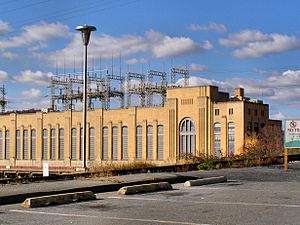Safe Harbor Dam facts for kids
The Safe Harbor Dam (also called the Safe Harbor Hydroelectric Station) is a large concrete dam and power plant on the lower Susquehanna River in Pennsylvania. It was built between 1930 and 1931 during the Great Depression. This dam created a long, shallow lake called Lake Clarke. It is one of three major dams built in the area around that time to produce electricity.
Quick facts for kids Safe Harbor Dam |
|
|---|---|

The east end of the turbine hall for the Safe Harbor Dam housing the 25 Hz turbines.
|
|
| Official name | Safe Harbor Hydroelectric Station |
| Location | Manor Township, Lancaster County / Chanceford Township, York County, Pennsylvania, USA |
| Coordinates | 39°55′14″N 76°23′33″W / 39.92056°N 76.39250°W |
| Construction began | April 1, 1930 |
| Opening date | December 7, 1931 |
| Operator(s) | Brookfield Renewable Partners |
| Dam and spillways | |
| Type of dam | Gravity |
| Impounds | Susquehanna River |
| Height | 75 ft (23 m) |
| Length | 4,869 ft (1,484 m) |
| Spillway type | Service, controlled |
| Spillway capacity | 1,120,000 cu ft/s (31,715 m3/s) |
| Reservoir | |
| Creates | Lake Clarke |
| Power station | |
| Turbines | 7 × 33.0 MW 5 × 37.5 MW 2 × 2 MW |
| Installed capacity | 422.5 MW |
Some of the dam's turbines create a special type of electricity. This power is used for Amtrak's 25 Hz traction power system, which helps run trains. The dam can also change power between 25 Hz and the 60 Hz used by most homes and businesses.
Contents
What the Area Was Like Before the Dam
Before the Safe Harbor Dam was built, the Conejohela Valley was a mix of marshy land and thick woods. The Susquehanna River here had rapids and small waterfalls. This area was a floodplain, meaning it often flooded, sometimes reaching all the way to Maryland.
These different types of land created many homes for various plants and animals. The difficult terrain also made it hard to travel across the lower Susquehanna River. This led to the opening of Wright's Ferry in 1730. Later, the first Columbia-Wrightsville Bridges were built, which were once thought to be the longest covered bridges in the world.
Where the Dam is Located
The Safe Harbor Dam is located near where the Conestoga River meets the Susquehanna River. This is about 7 miles (11 km) downstream from Washington Boro, Pennsylvania. The dam created Lake Clarke, which is now a very popular spot for water sports and fishing.
The lake has areas of different depths. These varying depths create valuable habitats for many kinds of fish. These include smaller fish, pan fish (like sunfish), and large game fish (like bass). So, while some animal habitats were lost when the lake was formed, new freshwater habitats were created.
Who Operates the Dam?
The Safe Harbor Dam and its power plant are operated by the Safe Harbor Water Power Corporation. This company is owned by Brookfield Renewable. Brookfield Renewable bought full ownership of the dam in 2014.
Building the Dam and Making Power
Planning for the Safe Harbor Dam began in 1929. Construction started on April 1, 1930. The dam's gates were closed for the first time on September 29, 1931. The dam started making electricity on December 7, 1931. The last of the first seven turbine units began working on October 14, 1940.
Later, in 1981, plans were made to make the dam produce even more electricity. New construction started on April 12, 1982. Five new turbine units were added between 1985 and 1986.
Two of the dam's units use special Kaplan turbines. These turbines create 25 Hz power for Amtrak's 25 Hz traction power system. Most of this power goes to Amtrak's station in Perryville, Maryland. The rest goes to stations in Royalton and Parkesburg, Pennsylvania. The dam also has a special machine that can change 25 Hz power to 60 Hz, or 60 Hz power to 25 Hz, when needed.
The other twelve units at the dam create 60 Hz power. In total, the Safe Harbor Dam can produce 417.5 megawatts of hydroelectric power. This power is sent through the PJM Interconnection, which helps manage electricity for a large part of the eastern United States.
Important Events at the Dam
On May 18, 2001, President George W. Bush visited the Safe Harbor Hydroelectric plant. He talked about his new energy plan for the country. Safe Harbor was chosen as a good example of how government, companies, and environmental groups can work together to produce energy.
In 2001, the Safe Harbor Water Power Corporation won the Governor's Award for Environmental Excellence. This award recognized their efforts to clean the river. They removed over 11,000 tons of trash and debris from the river. They were also able to recycle almost all of it.
See also
 In Spanish: Presa Safe Harbor para niños
In Spanish: Presa Safe Harbor para niños

